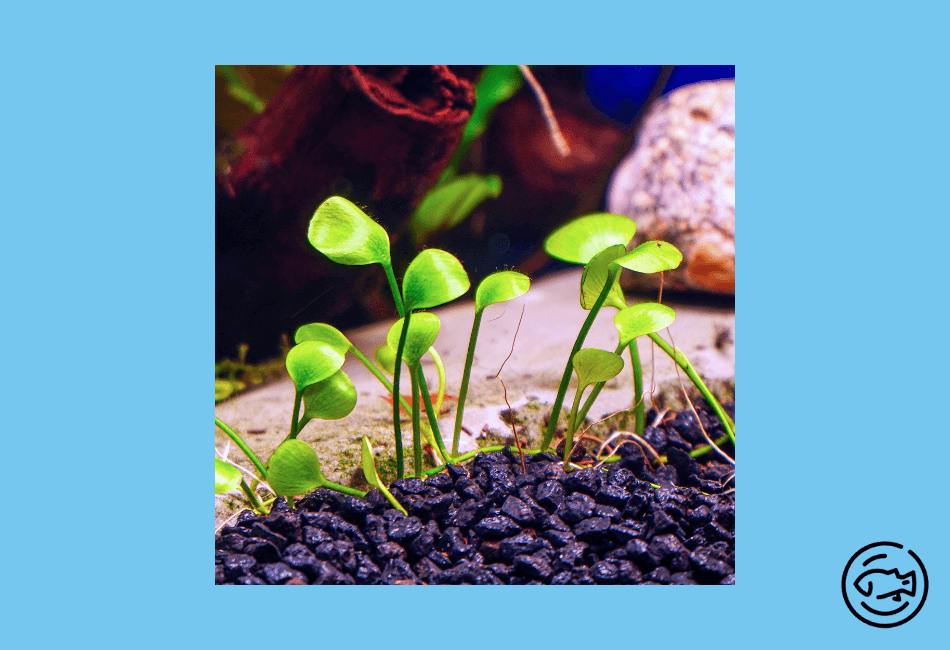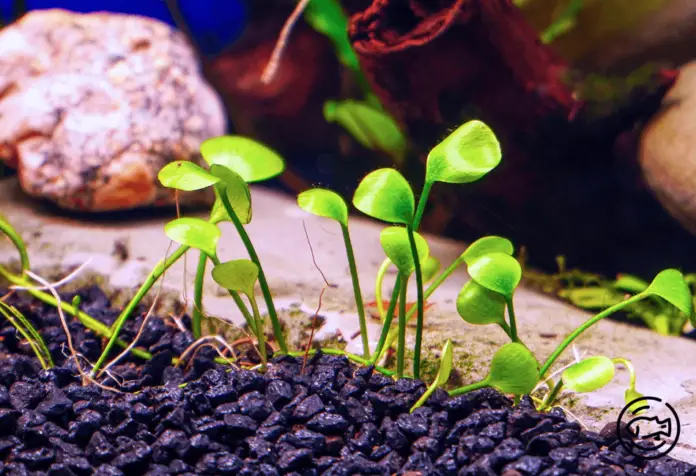Marsilea Hirsuta is a stunning aquatic plant that is simple to manage and perfect for novices.
It necessitates moderate to intense lighting to flourish, a ground-based substrate, and an aquarium climate varying from 18°C to 28°C.
Furthermore, it needs pH measurements within the range of 5 and 7.5.
Overview
Marsilea Hirsuta is a commendable aquatic plant, ideally suited for the frontal view in a tank setup. This petite plant, exhibiting a clover-like appearance, indicates slow growth and, when sown in clusters, can establish a carpet-like expanse in the aquarium.
Contrary to many front-dwelling aquarium flora that typically demands substantial upkeep to flourish, this plant is relatively low maintenance.
Under moderate to intense light conditions, it will cultivate in a low-lying, horizontally expanding manner. Bear in mind that if the light supply is insufficient, it may elongate and fail to establish the coveted carpeting effect.
Given its natural character, even hobby newcomers can successfully cultivate this plant. Demonstrating tolerance to various circumstances, it promises healthy growth provided its basic requirements are fulfilled.
It doesn’t mandate any particular substrate or water conditions to prosper within your tank.
| Attribute | Details |
|---|---|
| Scientific Classification | Marsilea Hirsuta |
| Family Group | Marsileaceae |
| Maintenance Requirements | Simple to Intermediate |
| Growth Speed | Leisurely to Average |
| Largest Possible Size | Up to 4 inches |
| Smallest Suitable Aquarium | 10 gallons |
| Optimal Water Temperature | 20 – 25 °C |
| Required Light Intensity | Moderate to High |
| Reproduction Method | Division |
| Ideal Location in Tank | Primarily Foreground/Midground |
Appearance

This petite, trailing perennial boasts slender stems carrying either two, three, or four-segmented fronds in a typical form once it’s fully established. Marsilea Hirsuta hails from the Mint family.
The Marsilea Hirsuta showcases short stalks adorned with leaves resembling a clover at the terminus, contributing to its circinate leaves – with a diameter spanning between 0.2 and 0.4 inches – that are circular and divided into two to four sections. They are part of the Asteraceae lineage.
Contrary to Marsilea quadrifolia, which tends to produce buoyant leaves that ascend toward the water’s surface, Marsilea Hirsuta remains submerged and abstains from creating any floating leaves.
Their moniker is derived from their elongated, slender, creeping rhizome enveloped in tiny, brownish fur. Moreover, the plant flaunts a dark green tint that is notably darker when directly lit.
Species Diversity of Marsilea Hirsuta
The Marsilea genus, frequently referred to as pepperwort or water clover comprises over 65 species of aquatic ferns.
Size
The usual Marsilea Hirsuta reaches a height of 3 inches for its minor variants and up to 4 inches for its more effective forms.
Remember that the plant can thrive entirely submerged as long as the soil it’s provided with remains adequately damp when in this immersed condition.
Origin
Originally hailing from Australia, Marsilea Hirsuta is a versatile amphibious flora capable of partially or wholly underwater flourishing. It adapts well to various soil compositions, be it sandy or clay-based terrains.
When fully submerged, this plant tends to modify its usual four-leaf structure, developing more significant, single-lobed foliage of a deep green hue.
Marsilea Hirsuta flourishes under intense illumination and can endure water temperatures reaching 84°F. The native aquatic environments of this species usually have neutral pH levels, though it has been reported to thrive in water with pH levels ranging from 6.2 to 7.5.
How To Use Marsilea Hirsuta In Your Aquarium
Given its gradual growth pattern and propensity to form a carpet-like spread, Marsilea Hirsuta serves as an excellent choice for the front sections of aquariums.
With the right amount of illumination, the plant maintains a relatively short stature while generating a verdant ground cover. This can be particularly appealing for aquarium enthusiasts aiming for a lush, dark-green carpet effect in their tanks.
Thanks to its vibrant leaf color and the dense spread it forms under suitable light conditions, this plant contributes to an aesthetically pleasing aquarium setting by adding an illusion of depth. Its versatility, being able to thrive both underwater and above the waterline, further endears it to seasoned aquarists.
For those maintaining tanks with freshwater shrimp, Marsilea Hirsuta is an ideal choice. It offers a great flat surface for the shrimp to perch on.
Just ensure that the plant receives adequate lighting and a sufficient supply of carbon dioxide. These factors will foster a quicker growth rate and a more pronounced, structured spread.
Tank Conditions
Cultivating this flora requires no special requirements; verify that fundamental factors like water, soil base, and light are held at recommended optimal levels. Here are some favorable growth conditions for this plant:
Make sure that the aquarium water temperature hovers between 18°C and 28°C. The appropriate pH scope for the aquarium should range from 5 to 7.5.
The water’s general hardness (GH) should fluctuate between 1 to 20 degrees hardness (dH).
Tank Size & Specifications
Considering that Marsilea Hirsuta reaches up to four inches tall, it’s recommended to employ a 10-gallon aquarium. In larger tanks, they can still be visually appealing, but for the desired effect, pairing them with other taller aquatic plant varieties is suggested.
Through photosynthesis, Marsilea Hirsuta releases oxygen and purifies the tank water, which is advantageous for the fish inhabitants.
Ideal Aquarium Capacity for Marsilea Hirsuta
The suggested aquarium capacity for Marsilea Hirsuta stands at 10 gallons.
Substrate
Marsilea Hirsuta favors a soil-based foundation when fully immersed, though fine-grained sand can also be used effectively.
Suggested soil substrates for this aquatic plant include ADA Amazonia aquatic soil, Carib Sea’s Eco-Complete, Seachem’s Flourite, and CaribSea’s Eco-Complete Enhanced.
Water Temperature
The Marsilea Hirsuta is impressively adaptable, making it an excellent fit for a variety of water settings and particularly well-suited for communal aquarium setups.
- The water temperature that best supports Marsilea Hirsuta ranges between 18°C and 28°C.
- Maintaining an optimal pH level between 5 and 7.5 will promote the health and growth of Marsilea Hirsuta.
- The hardness of the water should ideally fall within the range of 1 to 20 dH.
Lighting Conditions
One of the most practical methods to enhance the vitality and ground-covering capacity of Marsilea Hirsuta is to provide medium lighting. It thrives when the Photosynthetically Active Radiation (PAR) ranges between 30 and 60.
The plant extends runner-like shoots across the substrate’s surface throughout its growth phase. Given sufficient light, it will form a dense, mat-like structure, noticeable even from afar. Under less optimal lighting conditions, the leaves will grow higher and more scattered, thereby reducing the formation of the typical carpet-like aesthetic.
This undemanding flora necessitates consistent moderate to high illumination to preserve its low-profile growth pattern and to sprawl across the tank’s base. This characteristic makes it a favourite among aquarium enthusiasts.
The majority of specimens you procure will likely have been cultivated partially submerged before your purchase, and a period of adaptation will ensue once these plants are established in your aquarium.
Avoid minimal lighting while nurturing this plant since it encourages vertical expansion, thus compromising the plant’s inherent ground-covering potential.
Tank Mates
Given its stature, Marsilea Hirsuta serves as an excellent shelter for bottom-dwelling aquatic creatures. These species can find solace within their foliage when evading other fish or intense light.
Marsilea Hirsuta appeals to community tanks because they can withstand many environmental factors, including elevated temperatures.
Marsilea Hirsuta is a superb selection for a fish tank as it demands minimal upkeep. Its ability to endure diverse environmental conditions mitigates potential compatibility conflicts.
Recommended Marsilea Hirsuta Companions:
- Cory Catfish
- Kuhli Loaches
- Sunburst Platies
- Otocinclus Catfish
- Molly Fish
- Zebra Danios
- Neon Tetras
- White Cloud Mountain Minnows
- Cherry Barbs
- Swordtail Fish
- Bleeding Heart Tetras
- Yoyo Loaches
Ill-suited Companions for Marsilea Hirsuta:
- Goldfish
- Clown Loaches
- Koi Fish
- Rainbowfish
- African Cichlids
- Oscar Fish
- Jack Dempsey Cichlids
Propagation Of Marsilea Hirsuta
Maintaining this plant is straightforward as it requires less attention than some other aquatic varieties. It can thrive even in lower light conditions. To guide you on how you can multiply the plant, here are some practical steps:
- To propagate a new plant, take a 1 to 2-inch piece of its rhizome and plant it in the substrate.
- Repeat the first step at regular intervals to populate your aquarium with multiple plants.
- Patience is essential; seeing significant growth from the newly transplanted plants might take a while, but steady growth will follow once they’ve established themselves.
- To maintain an organized look in the aquarium as the plants begin to flourish, manage the thickness of the plant mat. This can be done by extracting the plant’s runners and giving them a trim.
- To encourage the development of a carpet-like layout, ensure the plant receives plenty of light. Supplementing the tank with CO₂ injections will make the plant leaves denser and deeper green.
Plant Features Of Marsilea Hirsuta
This flora is renowned for its low, thick growth of dark green foliage, frequently creating a carpet-like impression under intense lighting and ample carbon dioxide injections.
In dimmer light conditions, it will extend taller and longer, thereby losing its remarkable ability to form a rug-like formation.
Marsilea Hirsuta is an aquatic species that can flourish both above the waterline and completely underwater. It propagates asexually and favors damp substrates to thrive when fully submerged.
Facts
As per nature enthusiasts, species of Marsilea are aquatic or amphibious, with their roots entrenched in mud or moist terrain.
- This plant grows slowly, achieving a modest stature of merely a few centimeters/inches high, extending its bountiful runners across the area to generate lush, appealing mats of leaves.
- Marsilea was christened after Count Luigi Ferdinando Marsilea, an Italian nature scholar from the 19th century.
- They provide a secure refuge for tiny bottom-dwelling fish and shrimps to shield themselves from harsh conditions. They also serve as ideal breeding territories for egg deposition.
- The Marsilea genus includes over 65 varieties of aquatic ferns, often referred to as pepperwort or water clover.
- This species propagates through the division of rhizomes. The plant sprouts new branches, which subsequently split and develop into a new plant.
- It possesses dark or lime green blades that can measure up to 1 cm in length and a width of 5 mm, with circinate leaves.
- Depending on the conditions, it can grow partially submerged or fully underwater in shallow, stagnant water on sandy or clay-based soils.
- The plant generates rhizomes, which are underground stems. For a rug-like appearance, severing the rhizome and pruning it regularly along its length is necessary.
- For those searching for a vibrant ground cover for their aquarium floor, the Marsilea Hirsuta collection is the perfect destination.
Conclusion
Marsilea Hisuta is a popular front-position aquatic plant, initially obtained from the Australian Archipelago. It’s a low-maintenance plant that flourishes both underwater and in above-water conditions.
It tends to develop a rug-like pattern when it’s provided with adequate lighting and carbon dioxide.
Conversely, under inadequate light conditions, the plant tends to sprout upwards, thereby losing its ability to form rug-like formations.
It’s a commendable freshwater aquarium plant to maintain and is suitable for novices just venturing into the hobby.


